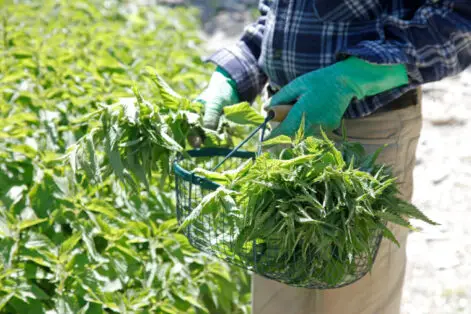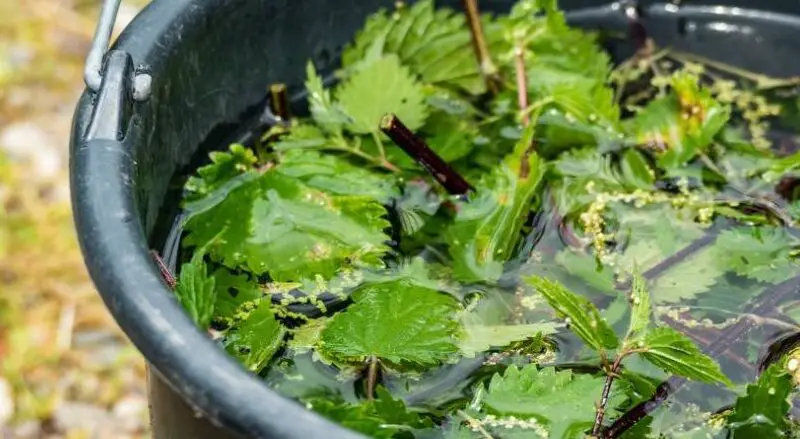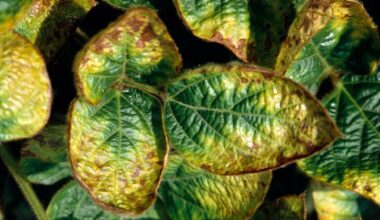Nettle fertiliser is mainly used to fertilize and stimulate soil life. It provides nitrogen, but it is also rich in minerals (iron, potassium, magnesium …) and trace elements.
Its use will stimulate growth and improve the chlorophyll function of plants. Nitrogen is especially necessary during the growth phase: it will promote the development of stems and leaves.
Even if nettle liquid manure is effective on most plants, it works even better on plants that need a large food supply, here is a list of 10:
- Fruit Trees
- Bushes
- Roses
- Annuals/Perennial flowering plants
- Tomato
- Leeks
- Cucumbers
- Courgettes
- Eggplant
- Celery
Contents
Why use nettle fertiliser?
Rich in nitrogen, but also in various other nutrients such as trace elements and minerals (iron, magnesium, potassium), it proves to be a very good natural fertilizer. Indeed, thanks to these elements, it will stimulate plant development and improve the chlorophyll system. Nitrogen helps promote the growth of aerial parts and the root system.
The nettle fertiliser does not only have an action on the plant in itself, it also has an action on the soil and the exchanges with the plants: rich in bacteria, enzymes and ferments, it brings these bacteria and micro-organisms to the soil and thus multiplies the activity of all the organisms found there. The nutrients brought to the soil are more quickly decomposed and made available to the plants.
How to make nettle fertiliser
The nettle fertiliser recipe is both a traditional recipe but which has never been so much in fashion thanks to its organic and totally natural side.
The use of 100% natural products in the garden is a guarantee of success to treat your plants or to make fertilizer while protecting the planet.
We can also note that nettle fertiliser is not expensive because you just need to own a sprayer.
The recipe for easy nettle fertiliser:
Rip out the nettles :
Put them in a tray or bucket (avoid metal trays).
Mix with water:
The following doses must be respected:
Fertilizer => 1 kg of nettle for 10L of water
Repellent => 1 kg of nettles for 20L of water
Leave to macerate :
1 to 2 weeks while stirring every two days approximately.
Filter the nettle liquid fertiliser solution:
You only have to recover the mixture and get rid of the nettle residues (spread them on the compost).
Thanks to this mix, you make great savings and above all a very nice gesture for the environment.
One of grandma’s tricks is also to put a big handful of nettles at the bottom of the hole of your tomato plantations and other vegetables in the vegetable garden to improve the tomato harvest.

How to make it odourless?
A liquid fertiliser being the product of a fermentation, it cannot be “odourless”. However, there is a difference between the normal odor of a successful liquid manure, which has a not very strong odor similar to cow urine, and a liquid manure that has failed because the mixture has putrefied instead of fermenting. In this case the odor may indeed be pestilential. So to make a liquid manure without a foul-smelling odor (which normally smells like manure (!!), it is necessary to prevent the preparation from rotting. To do this, a few precautions are necessary:
- Place your container in the shade. Fermentation will take place less quickly but more reliably.
- Do not cover the container tightly: the fermentation will release gases that will stagnate in the container and give off a bad smell.
- Most importantly, stir the mixture every day, or even several times a day, for several minutes, lifting all the material well. It will be easier if the nettle has been cut into small pieces.
The officinal sage or lithothamnion (seaweed very rich in minerals) that we advise to add to avoid the exhalations of the liquid manure can show a certain efficiency, but they should be added only at the end of the fermentation. Sage will indeed block this fermentation, just like lithothamnion which is very concentrated in limestone. Adding one or the other once the fermentation is over can protect the manure and prevent further fermentation.
How to use nettle fertiliser
In watering
Before watering your vegetables, dilute to 10% (1 liter of liquid manure with 9 liters of water). It is generally used in the spring, during the growing phase.
Be careful not to have a heavy hand, an excess of nitrogen can burn your vegetables. It can also affect the quality of the fruits and they will keep less well. The smell of liquid manure can also attract certain pests.
In foliar spraying
You can also spray liquid manure on the leaves of the plants which will absorb the elements through the foliage.
Here you must dilute to 5% (1 liter of liquid manure in at least 19 liters of water). Then spray the mixture on the leaves and stems. Stop when large drops form on the leaves.
Soaking
Before transplanting your vegetables, you can soak them in 20% diluted nettle fertiliser (1 liter of liquid manure, 4 liters of water). In complement or not of a pralinage, make soak during 30 minutes the roots of cabbages, salads, leeks? This also works with trees and shrubs.
Compost gas pedal
Nettle fertiliser is also used to activate and accelerate the decomposition of compost waste. Pour the remaining liquid manure filter residue on your waste pile.
Do not abuse nettle fertiliser!
- Too much nitrogen in a plant can attract pests,
- Nitrogen is useful for the growth of leaves and stems, not for flowers and fruit, nor for roots, so the period of use of nettle fertiliser, especially in watering, is limited to the growing season. For the rest of the growing period, prefer comfrey manure or mix the two to restore the balance.
- When the soil is dry, avoid using liquid manure.
Summary
The nettle itself already possesses many properties, which will be optimized by the realization of the manure. Indeed, this one requires a fermentation which will bring other beneficial elements. Its richness in main nutrients, such as nitrogen or potassium, are real growth activators.









